
laser_measurement_instruments_catalog
.pdf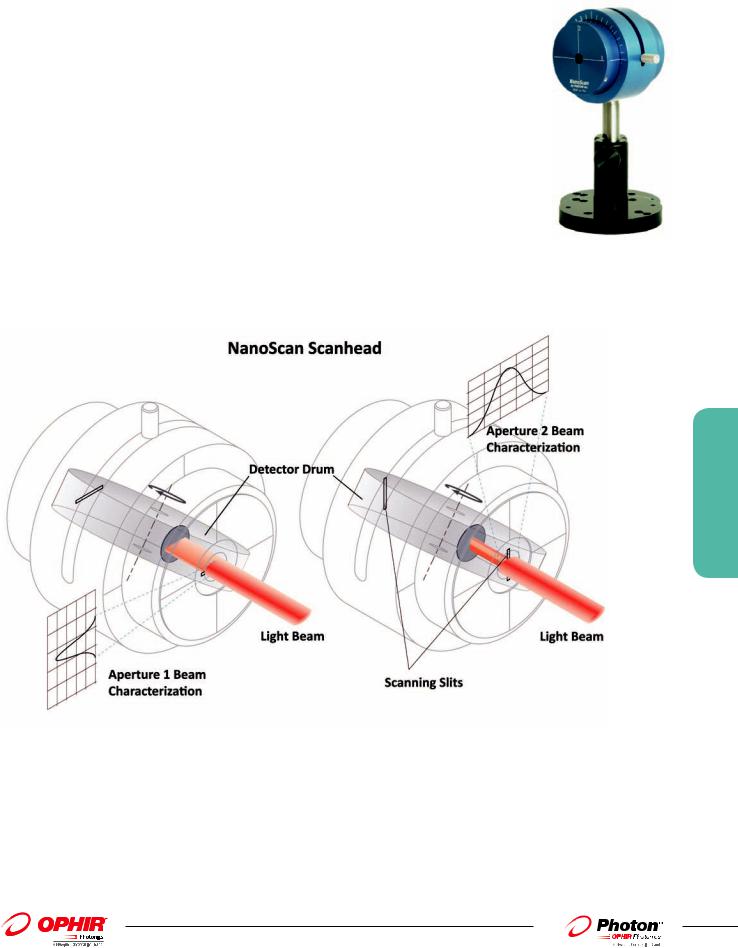
3.3 Introduction to Scanning-Slit Profilers
The scanning slit beam profiler moves two narrow orthogonal slits in front of a linear photo-detector through the beam under analysis. Light passing through the slit induces a current in the detector. Thus, as the slit scans through the beam, the detector signal is linearly proportional to the spatial beam irradiance profile integrated along the slit. A digital encoder provides accurate slit position. The photo-induced current signal is digitized and analyzed to obtain the beam profile in both X and Y from the two orthogonal slits.
The slit apertures act as physical attenuators, preventing detector saturation for most beam applications. High dynamic range amplification allows operation over many orders of magnitude in beam power.
From these profiles, important spatial information such as beam width, beam position, beam quality, and other characteristics are determined. This technique can accommodate a wide variety of test conditions. Because slit scanners measure beams at high powers with little or no attenuation, they are ideal to profile beams used in material processing.
Carbon dioxide (CO2) lasers are widely used in materials processing, and have a 10.6 micron wavelength that cannot be profiled with most cameras. Slit scanners, therefore, provide an convenient means of measuring high-resolution CO2 lasers with powers up to and exceeding 1000 watts.
3.3 Beam Analysis
159
For latest updates please visit our website: www.ophiropt.com/photonics |
|
01.01.2014 |
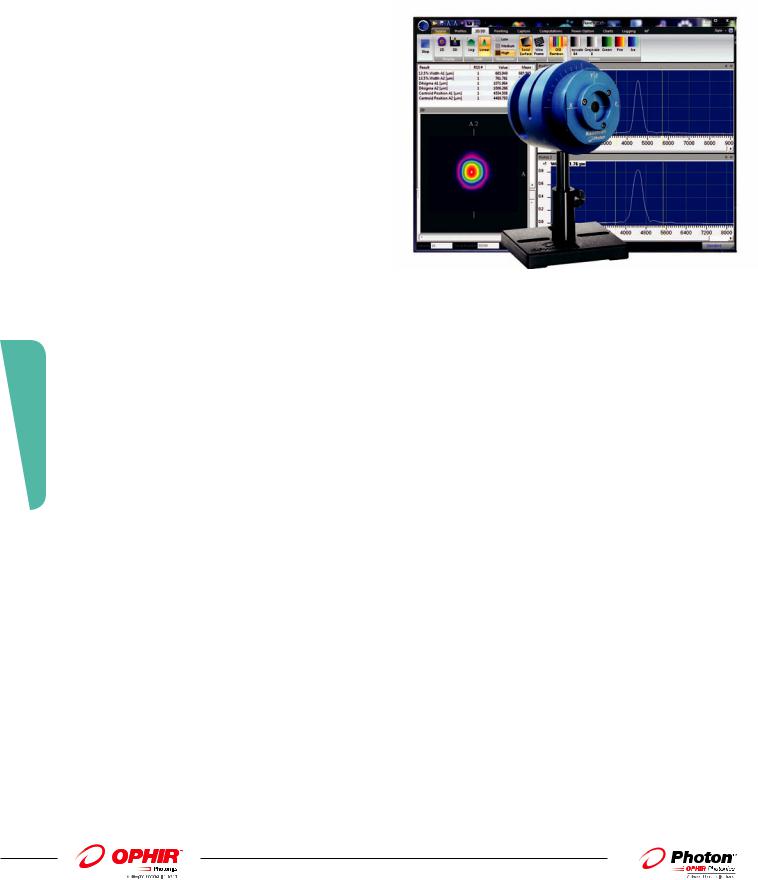
3.3.1 Beam Analysis
160
3.3.1 NanoScan 2
Scanning Slit Beam Profiler For High Accuracy Dimensional Measurementt
NanoScan 2 combines the convenience and portability of direct USB connectivity with the speed, accuracy, and dynamic range that users have come to expect from the Photon NanoScan slit based profilers. The NanoScan 2 is available with a silicon, germanium or pyroelectric detector, which allows it to profile lasers of any wavelength
from UV to far infrared, out to 100µm and beyond. With the new NanoScan 2 software package, the user can configure the display interface however it is desired; displaying those results of most interest on one easy-to-read screen, or on multiple screens.
The NanoScan slit profiler is the most versatile laser beam profiling instrument available today: providing instantaneous feedback of beam parameters for CW and kilohertz pulsed lasers, with measurement update rates to 20Hz. The natural attenuation provided by the slit allows the measurement of many beams with little or no additional attenuation. The high dynamic range makes it possible to measure beams while adjustments to focus are made without having to adjust the profiler. Just aim the laser into the aperture and the system does the rest!
Capabilities
NanoScan 2 is a PC-based instrument for the measurement
and analysis of laser beam spatial irradiance profiles in accordance with the ISO standard 11146. The scan heads also measure power in accordance with ISO 13694.
NanoScan uses the scanning slit, one of the ISO Standard scanning aperture techniques. It can measure beam sizes from microns to centimeters at beam powers from microwatts to over kilowatts, often without attenuation. Detector options allow measurement at wavelengths from the ultraviolet to the infrared.
The NanoScan2 digital controller has 16-bit digitization of the signal for enhanced dynamic range up to 35dB power optical. With the accuracy and stability of the beam profile measurement you can measure beam size and beam pointing with a 3-sigma precision of several hundred nanometers. The software controllable scan speed and a “peak-connect” algorithm allows the measurement of pulsed and pulse width modulated lasers with frequencies of 10kHz and higher*. The NanoScan is also able to measure up to 16 beams, or regions of interest, in the aperture simultaneously.
Benefits
ֺAbsolute measurement accuracy is guaranteed by NIST traceable calibration of every NanoScan
ֺMeasure any wavelength from UV to very far infrared (190nm to >100µm)
ֺInstantaneous real time display of results; beam found in less than 300ms and updated at up to 20Hz
ֺWaist location can be determined to within ±25µm due to the well-defined Z-axis datum plane of the NanoScan
ֺMeasure pulsed and CW lasers
ֺFor pulsed beams the pulse rate is measured and reported
ֺFrom as small as 8µm beams, can be measured directly with guaranteed accuracy and precision
ֺAdditional high signal to noise ratio can be achieved with averaging
ֺZ-axis caustic measurements are available with built-in mechanical linear stage control
ֺM2 propagation ratio values available with simple M2 Wizard included with the software.
ֺAny beam result can be charted and monitored over time
ֺPower levels can be monitored along with spatial measurements to determine if losses are introduced by beam adjustments
ֺLog results to text files for independent analysis
ֺAutomate the system using optional ActiveX Automation commands, available with the PRO version software and scan heads Samples of automation programs included for Excel,VBA, LabView and Visual Basic.net
*The minimum frequency is a function of the beam size and the scan speed. This is a simple arithmetic relationship; there must be a sufficient number of pulses during the time that the slits sweep through the beam to generate a meaningful profile. Please refer to Photon’s Application Note, Measuring Pulsed Beams with a Slit-Based Profiler.
01.01.2014 |
|
For latest updates please visit our website: www.ophiropt.com/photonics |
|
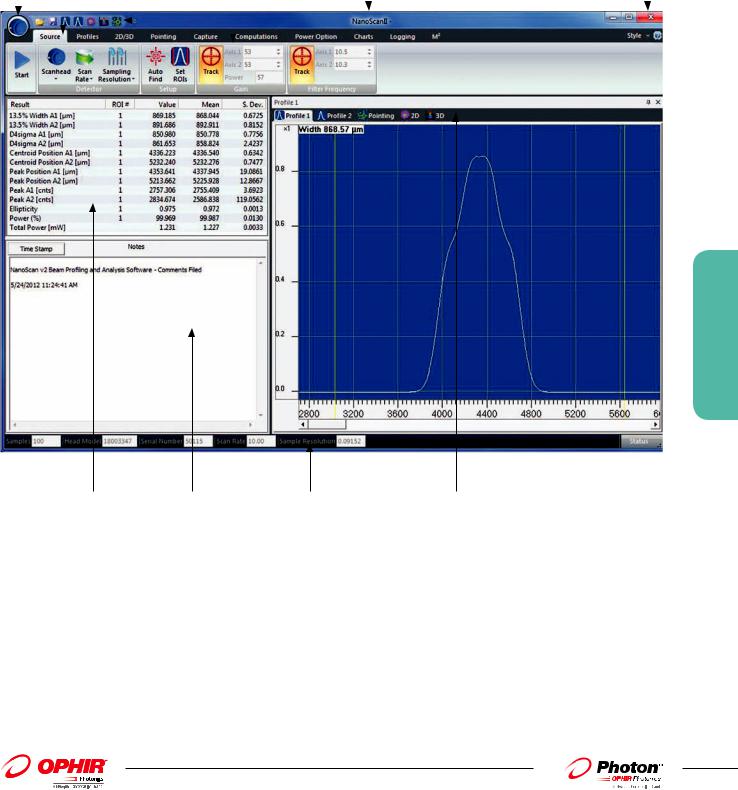
NanoScan 2 Configurable User Interface
In addition to new hardware, the NanoScan2 has an updated integrated software package for the Microsoft Windows Platform, which allows the user to display any of the results windows on one screen. The NanoScan 2 software comes in two versions, STD and PRO. The NanoScan2 Pro version includes ActiveX automation for users who want to integrate the NanoScan into OEM systems or create their own user interface screens with C++, LabView, Excel or other OEM software packages.
File Menu |
Quick Access Toolbar Panel |
Title Bar |
Ribbon Bar |
Standard Windows |
|||||||||
|
Ribbon Tabs |
|
|
|
|
|
|
|
Controls |
|
|||
|
|
|
|
|
|
|
|
|
|||||
|
|
|
|
|
|
|
|
|
|
|
|||
|
|
|
|
|
|
|
|
|
|
|
|
|
|
|
|
|
|
|
|
|
|
|
|
|
|
|
|
|
|
|
|
|
|
|
|
|
|
|
|
|
|
|
|
|
|
|
|
|
|
|
|
|
|
|
|
|
|
|
|
|
|
|
|
|
|
|
|
|
|
|
|
|
|
|
|
|
|
|
|
|
|
|
|
|
|
|
|
|
|
|
|
|
|
|
|
|
|
3.3.1 Beam Analysis
Results Window |
User Notes |
Status Bar |
Primary Dock Window (note tabs) |
Example of display configuration window
161
For latest updates please visit our website: www.ophiropt.com/photonics |
|
01.01.2014 |
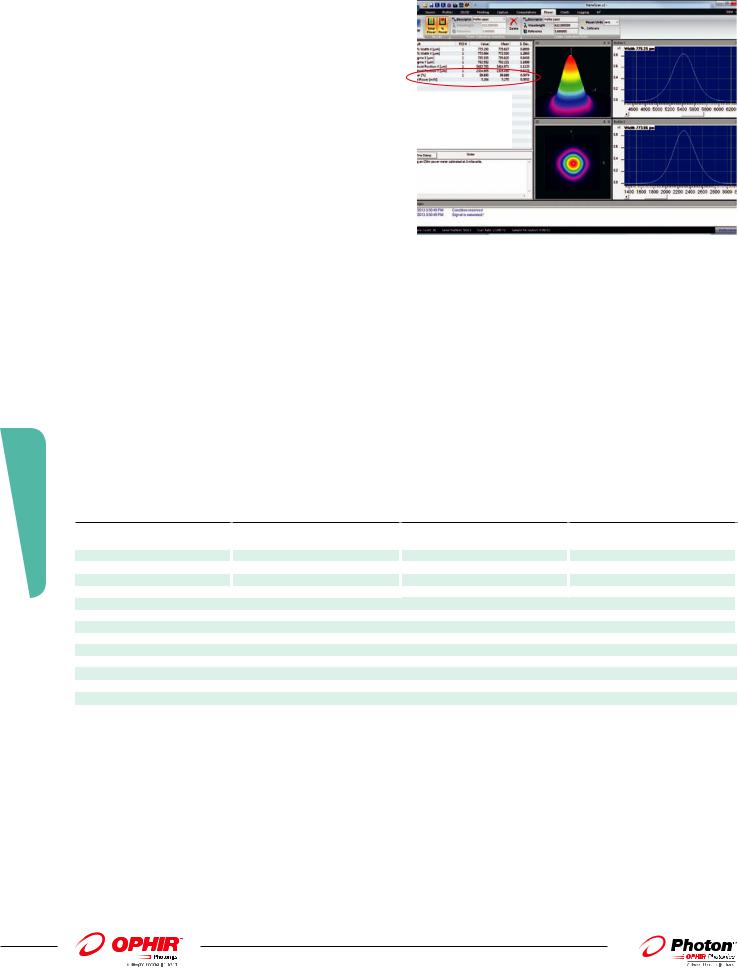
Integrated Power Meter
The silicon and germanium detector equipped NanoScan 2 systems include an integrated 200mW power meter. The scanhead comes with a quartz attenuator window that provides a uniform response across a broad wavelength range.
This is a relative power meter that has better than 1.5% correspondence when calibrated with a user-supplied power meter and used in the same configuration as calibrated.
The power meter screen in the software shows both the total power and the individual power in each of the beams being measured.
Available Detectors
The NanoScan 2 is available with silicon, germanium or pyroelectric detectors to cover the light spectrum from UV to very far infrared.
% of power within the aperture integrated power measurement calibrated with customer power sensor
3.3.1 Beam Analysis
162
Apertures and Slits
The NanoScan 2 is available with a variety of apertures and slit sizes to allow for the accurate measurement of varying beam sizes. The slit width defines the minimum beam width that can be measured; due to convolution error, the slit should be no larger than ¼ the beam diameter to provide a ±3% accurate measurement. For this reason the minimum beam diameter measureable with the standard 5µm slit is 20µm. To measure beams smaller than 20µm it is necessary to use the small aperture 1.8µm slit instrument, providing a minimum beam diameter of ~8µm. Because these slits are so narrow, the maximum length limits the aperture to 3.5mm. Contrary to many people’s beliefs, these smaller slits do not improve the resolution of the measurement, only the minimum size of the beam. Therefore, unless it is necessary to measure beams less than 20µm, one would be advised to stick with the 9mm/5µm configurations.
For very large beams, NanoScan is available with a large 20 or 25mm aperture with 25µm slits. These sensor are larger than the standard scan heads (100mm diameter)
NanoScan 2 Scanhead Model |
|
Si/3.5/1.8µm |
|
|
Si/9/5µm |
|
Si/9/25µm |
|
|
|
|
|
|
|
|
|
|
|
|
|
|
|
|
|
|
|
Wavelength |
190nm - 950nm |
|
190nm - 950nm |
190nm - 950nm |
|
|||
Slit Size |
|
1.8µm |
|
|
5µm |
|
25µm |
|
Aperture Size |
|
3.5mm |
|
|
9mm |
|
9mm |
|
1/e2 Beam Diameter Range |
|
7µm-~2.3mm |
|
|
20µm-~6mm |
|
100µm-~6mm |
|
Spatial Sampling Resolution |
|
|
5.3nm-18.3µm |
|
|
|
||
Profile Digitization |
|
|
16-bit |
|
|
|
||
Scan Frequency |
|
|
1.25,2.5,5.10.20Hz |
|
|
|
||
Power Reading |
|
|
User calibrated |
|
|
|
||
Power Aperture Window |
|
|
Metalized Quartz (200mW upper limit) |
|
|
|
||
Laser Type |
|
|
CW or Pulsed |
|
|
|
||
Operating Range |
|
|
See Operating Space Charts |
|
|
|
||
Damage threshold |
|
|
See Operating Space Charts |
|
|
|
||
Rotation Mount |
|
|
Standard |
|
|
|
||
Scanhead Dimension |
|
|
63.4mm diameter x102.6mm long |
|
|
|
||
|
|
|
See Mechanical Drawing for details |
|
|
|
||
|
|
|
|
|
|
|
|
|
01.01.2014 |
|
For latest updates please visit our website: www.ophiropt.com/photonics |
|

NanoScan 2 Scanhead Model |
|
Ge/3.5/1.8µm |
|
|
Ge/9/5µm |
|
Ge/9/25µm |
|
|
|
|
|
|
|
|
|
|
Wavelength |
700nm - 1800nm |
|
700nm - 1800nm |
700nm - 1800nm |
|
|||
Slit Size |
|
1.8µm |
|
|
5µm |
|
25µm |
|
Aperture Size |
|
3.5mm |
|
|
9mm |
|
9mm |
|
1/e2 Beam Diameter Range |
|
7µm-~2.3mm |
|
|
20µm-~6mm |
|
100µm-~6mm |
|
Spatial Sampling Resolution |
|
|
5.3nm – 18.3µm |
|
|
|
||
Profile Digitization |
|
|
16 bit |
|
|
|
||
Scan Frequency |
|
|
1.25, 2.5, 5, 10, 20Hz |
|
|
|
||
Power Reading |
|
|
User calibrated |
|
|
|
||
Power Aperture Window |
|
|
Metalized Quartz (200mW upper limit) |
|
|
|
||
Laser Type |
|
|
CW or Pulsed |
|
|
|
||
Operating Range |
|
|
See Operating Space Chart |
|
|
|
||
Damage Threshold |
|
|
See Operating Space Chart |
|
|
|
||
Rotation Mount |
|
|
Standard |
|
|
|
||
Scanhead Dimension |
|
|
63.4mm diameter x102.6mm long |
|
|
|
||
|
|
|
See Mechanical Drawing for details |
|
|
|
||
|
|
|
|
|
|
|
|
|
NanoScan2 Scanhead Model |
|
Pyro/9/5µm |
|
Pyro/9/25µm |
|
|
|
|
|
|
|
|
|
|
Wavelength |
190nm->100µm |
190nm->100µm |
||
Slit Size |
|
5µm |
|
25µm |
Aperture Size |
|
9mm |
|
9mm |
1/e2 Beam Diameter Range |
|
20µm-~6mm |
|
100µm-~6mm |
Spatial Sampling Resolution |
5.3nm-18.3 µm |
Profile Digitization |
16-bit |
Scan Frequency |
1.25,2.5,5.10.20Hz |
Power Reading |
Not Availble |
Power Aperture Window |
N A |
Laser Type |
CW or Pulsed |
Operating Range |
See Operating Space Chart |
Damage Threshold |
See Operating Space Chart |
Rotation Mount |
Standard |
Scanhead Dimension |
63.4mm diameter x102.6mm long |
|
See Mechanical Drawing for details |
|
|
3.3.1 Beam Analysis
163
For latest updates please visit our website: www.ophiropt.com/photonics |
|
01.01.2014 |
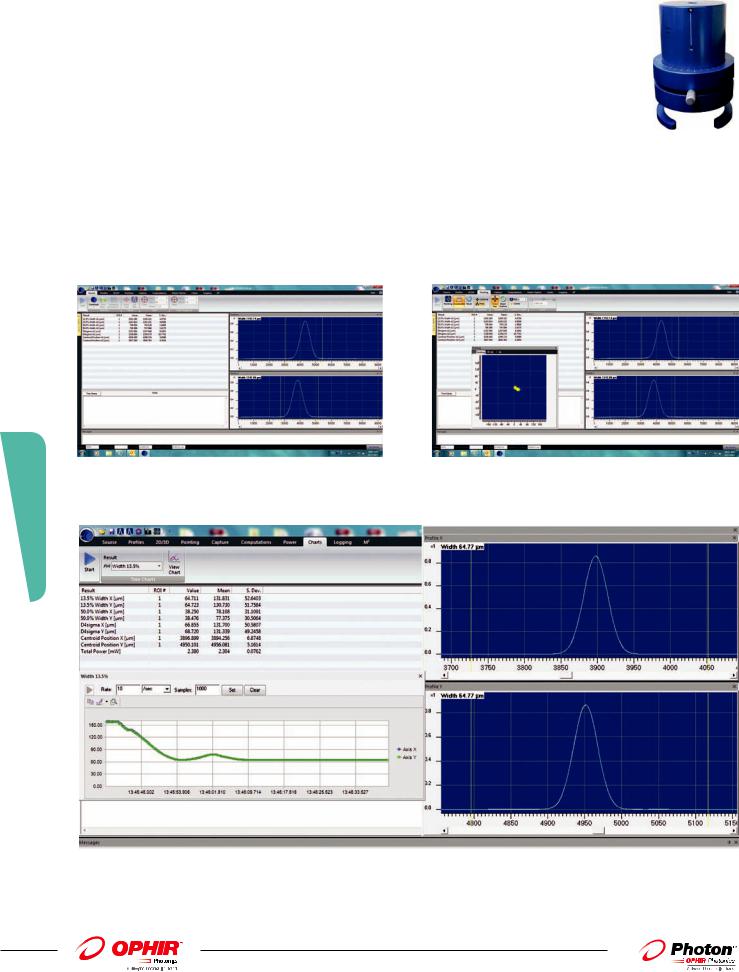
The Most Versatile and Flexible Beam Profiling System Available
With the available range of detectors, slit sizes and apertures the NanoScan 2 provides the maximum versatility in laser beam profiling. NanoScan 2 adds the convenience and portability of direct USB connectivity: no external controllers or power supplies required to operate the profiler. In addition the rotation mount has been redesigned to provide a
stand for vertical operation, if desired. The mount can be positioned in one of two places. If vertical operation is desired the mount is positioned toward the back of the scanhead to expose the stand, which can be affixed to the optical
table or stage. If standard horizontal operation is desired, then the rotation mount can be positioned in the forward configuration, maintaining the original length and size of the scanhead.
See Your Beam As Never Before
The new NanoScan2 graphical user interface (GUI) allows the user to set the display screens to any appropriate configuration, displaying those that are of interest and hiding what is not. This means that you can have the information that you want to see, uncluttered by extraneous output, and you can have all the features you need, visible at once. The screens can be docked or floating with ribbon bars for the controls that can be visible or hidden as desired. This allows you to take advantage of a large, multi-monitor desk top or maximize the useful information on a small laptop display.
3.3.1 Beam Analysis
Simple docked view of profiles and numerical results |
Both docked and undocked windows: profiles, results, and pointing |
Example of time charts used to monitor focusing process
164
01.01.2014 |
|
For latest updates please visit our website: www.ophiropt.com/photonics |
|
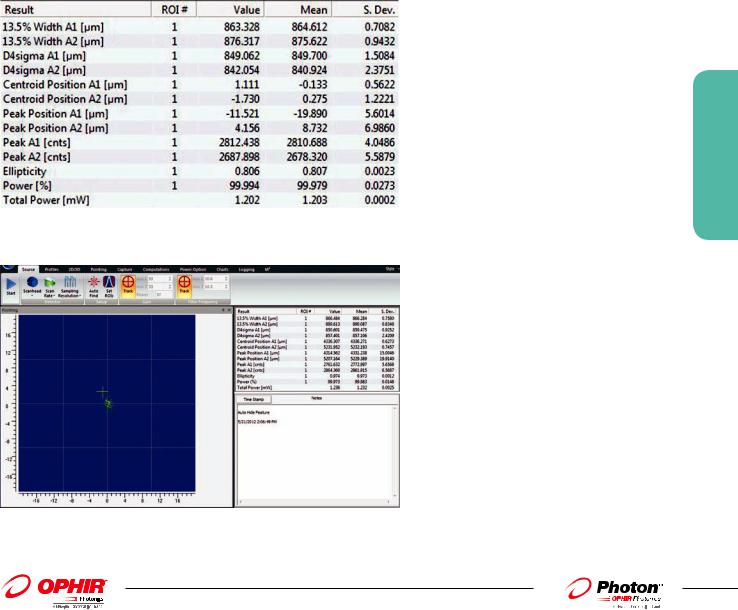
Measured Beam Results
From 1989 through 1996, John Fleischer, founder and past President of Photon Inc., chaired the working laser beam width ISO/DIN committee that resulted in the ISO/DIN 11146 standard. The final approved standard, available in 13 languages. The standard governs profile measurements and analysis using scanning apertures, variable apertures, area sensors and detector arrays. NanoScan 2 measures spatial beam irradiance profiles using scanning slit techniques.
Results measured include:
ֺBeam Width at standard and user-definable clip levels, including 1/e² and 4σ
ֺCentroid Position
ֺPeak Position
ֺEllipticity
ֺGaussian Fit
ֺBeam Divergence
ֺBeam Separation
ֺPointing Stability
ֺROI Power
ֺTotal Power
ֺPulsed Laser Repetition Rate
Example of the many measurements that can be made and the precision you can expect
Knowing pointing stability is a critical factor in laser performance
3.3.1 Beam Analysis
165
For latest updates please visit our website: www.ophiropt.com/photonics |
|
01.01.2014 |

3.3.1 Beam Analysis
166
M² Wizard
M-squared (M²) software Wizard is an interactive program for determining the “times diffraction limit” factor M² by the Rayleigh Method. The M² Wizard prompts and guides the user through a series of manual measurements and data entries required for calculating M².
The Optional Rayleigh Range Translation Test Fixture (RAL-FXT) provides convenient translation of a NanoScan scanhead assembly and a digital readout of its relative position along the Z-axis. Used with a user-provided focusing lens and the M² Wizard in the NanoScan Analysis Software, this fixture offers a quick and easy method to determine the times-diffraction propagation factor (M²) of a laser.
The RAL-FXT features a base plate, sliding carriage and digital micrometer. The base plate (5.4×10.2×0.38in.) provides a series of ¼-20 threaded mounting holes at 2in. centers to facilitate convenient fixturing of the assembly with respect to the focusing lens. The sliding carriage accommodates the combination of the 0.125-in. dowel pin and the ¼-20 mounting hole found on any Photon scan head’s rotation mount, and enables smooth movement of the scan head assembly over a 6-in. range of travel. A Mitutoyo micrometer with a handy re-zeroing feature and accompanying slide provides precise determination of the
scan head location and/or travel distance with a resolution of tens of microns. For automated and automatic M² measurements the NanoModeScan option is required.
|
The optional Translation Test Fixture |
|
makes manual M2 measurements |
Pulsed Laser Beam Profiling |
accurate and repeatable |
|
In addition to profiling CW laser beams, NanoScan can also
profile pulsed laser beams with repetition rate in the 10kHz range and above. To enable the
measurement of these pulsed lasers, the NanoScan profiler incorporates a “peak connect” algorithm and software-controlled variable scan speed on all scanheads. The accuracy of the measurement generally depends on the laser beam spot size and the pulse-to-pulse repeatability of the laser. The NanoScan is ideal for measuring Q-switched lasers and lasers operating with pulse width modulation power (PWM) control. In the past few years, lasers with picoand femtosecond pulse durations have begun to be used in many applications. Although these lasers add some additional complication to the measurement techniques, the NanoScan can also measure this class of laser.
Optional Automation Interface
For customer who want to incorporate the NanoScan2 into an automated procedure or to create a customized user interface, the PRO version scanheads include an ActiveX Automation Server that can be used by an Automation Client written in Visual Basic for Applications (VBA), C/ C++ or by an application which supports ActiveX Automation, such as Microsoft Excel, Microsoft Word or National Instruments’ LabVIEW. The software package include example of programs written in Excel and LabVIEW in the automation folder.
01.01.2014 |
|
For latest updates please visit our website: www.ophiropt.com/photonics |
|
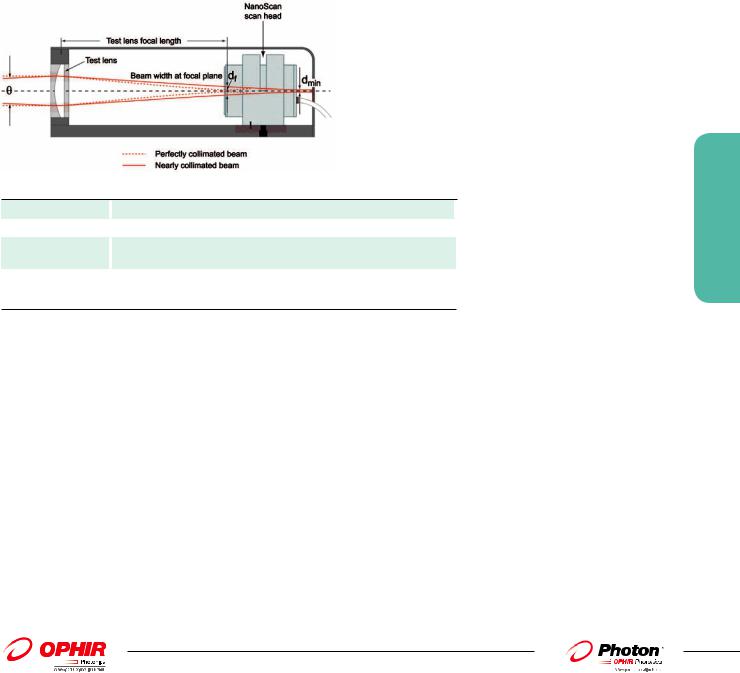
Optional Collimation Fixture
Collimation is one of the most common applications for which the NanoScan2 is used. The Collimation Fixture provides an easy and extremely accurate method for making this adjustment to a laser system.
The Collimation Fixture comprises a test lens with the NanoScan2 profiler positioned to measure the beam size at the geometric focus of the lens. From lens theory, the angle of collimation is determined by the equation:
θ = Dƒ / ƒ,
where θ is the angle of collimation, Dƒ is the beam size measured at the lens focal length, and ƒ is the focal length of the lens. Once the beam size is measured at the focal length of the lens, simply dividing this measured beam size by the focal length determines the laser beam collimation angle. Practically speaking, adjusting the optics to generate the smallest Dƒ, will result in the minimum
divergence angle. The beam profiler remains fixed, and active alignment is easily performed in real time. This level of simplicity, speed, and functionality is simply not possible with techniques involving multiple beam profile positions.
Divergence/Collimation test fixtures based on a high quality test lens to focus your collimated or diverging beam. Fixtures require a complete NanoScan System. Wavelength of use should be specified at time of order.
COL-FXT 250 COL-FXT 500 COL-FXT 250 TEL
COL-FXT C02
Nominal 250mm focal length lens. Includes an enclosure to block stray light Nominal 500mm focal length lens. Includes an enclosure to block stray light
Nominal 250mm focal length lens. For wavelengths of use at 1310 or 1550nm with lens repositioning. Includes an enclosure to block stray light
Zinc selenide (ZnSe) lens with a focal length of 190.5mm. For wavelength of use at 10.6m. Includes an enclosure that holds an adjustable entrance iris. Requires a Pyro NanoScan System
3.3.1 Beam Analysis
167
For latest updates please visit our website: www.ophiropt.com/photonics |
|
01.01.2014 |

3.3.1 Beam Analysis
168
NanoScan 2 Acquisition and Analysis Software
Use the Software specification from the existing NanoScan 2 data sheet
*Feature |
|
|
|
NanoScan Standard NanoScan Professional |
|
||
|
|
|
|
|
|
(all features in Standard plus) |
|
Controls |
|
|
|
|
|
|
|
Source |
|
ScanHead Select, Gain, Filter, Sampling Resolution, |
|
||||
|
|
AutoFind, Rotation Frequency, Record Mode |
|
||||
Capture |
|
Averaging, Rotation, Magnification, CW or Pulse Modes, |
|
|
|
|
|
|
|
Divergence, Gaussian Fit, Reference Position, Recompute |
|
||||
Regions of Interest (ROI) |
|
Single or Multiple, Automatic or Manual, Colors |
|
|
|
|
|
Profiles |
|
Vertical Scale (1´, 10´, 100´), Logarithmic Scale, Z & PAN |
|
|
|
|
|
|
|
(Automatic or Manual) |
|
||||
Computation: ISO 13694, ISO 11146 |
|
Dslit, (13.5%, 50% 2 User Selectable Clip Levels), D4Ó, Width |
|
|
|
|
|
|
|
ratios, Centroid Position, Peak Position, Centroid Separation, |
|
||||
|
|
Peak Separation, Irradiance, Gaussian Fit, Ellipticity, |
|
||||
|
|
Divergence, Total Power, Pulse Frequency, % power |
|
||||
|
|
|
|
|
|
|
|
|
|
Continuous, Rolling, Finite |
|
|
|
||
Pointing |
|
Centroid or Peak, Accumulate Mode, Beam Indicator, Graph |
|
|
|
|
|
|
|
Center, Colors |
|
||||
2D/3D |
|
2D or 3D Mode, Linear or Logarithmic Scale, Resolution, Fill |
|
|
|
|
|
|
|
Contours, Solid Surface, or Wireframe, Clip Level Colors |
|
||||
Charts |
|
Chart Select, Parameter Select, Aperture Select, Update |
|
|
|
|
|
|
|
Rate, Start and Clear |
|
||||
Logging |
|
File Path/Name, Delimiter, Update Rate |
|
|
|
|
|
M² |
|
Rail Setup: Com Port and Length, Connect/Disconnect, Rail |
|
|
|
|
|
|
|
Control |
|
||||
Views |
|
|
|
|
|
|
|
Profiles |
|
Displays Beam Profiles for each axis, with optional Gaussian |
|
||||
|
|
Overlays |
|
||||
Results |
|
Displays Values and Statistics for Selected results |
|
|
|
|
|
Pointing |
|
Displays the XY position of the Centroid or Peak for each |
|
|
|
|
|
|
|
ROI , with optional overlays and Accumulate Mode |
|
||||
Charts |
|
Displays Time Charts for User-selected results |
|
|
|
|
|
2D/3D |
|
Displays pseudo 2D/3D Beam Profile |
|
|
|
|
|
M² Wizard |
|
An interactive procedure for measuring M² by the Rayleigh |
|
|
|
|
|
File Saving |
|
Method |
|
||||
|
|
|
|
|
|
|
|
NanoScan Data Files |
|
|
|
|
|
|
|
Text Files |
|
|
|
|
|
|
|
Data Logging |
|
|
|
|
|
|
|
Log to File |
|
|
|
|
|
|
|
Reports |
|
|
|
|
|
|
|
NanoScan Report |
|
|
|
|
|
|
|
Automation Interface |
|
|
|
|
|
|
|
ActiveX Automation Server |
|
|
|
|
|
|
|
Minimum System Requirements |
|
|
|
|
|
|
|
PC computer running windows 7 (32/64) Laptop or Desktop1 A dual core processor CPU, 2GHz or better
2GB of RAM²
1-USB 2.0 port available
At least 250MB of free HDD space 1400 x 900 display resolution or better Graphics card w/hardware accelerator DVD-ROM drive
Microsoft compatible pointing devices(e.g., mouse, trackball, etc)
*Download the NanoScan Acquisition and Analysis Software Manual for a complete description of all Software Features
1.A business/professional version of windows is recommended. The NanoScan v2 software has not been tested with home versions of Windows. Both 64-bit and 32-bit versions of Windows 7 are supported. NanoScan v2 is no longer tested on Windows XP 32-bit operating systems.
2.The computer memory (RAM) will affect the performance of the software in the Data Recorder.
01.01.2014 |
|
For latest updates please visit our website: www.ophiropt.com/photonics |
|
